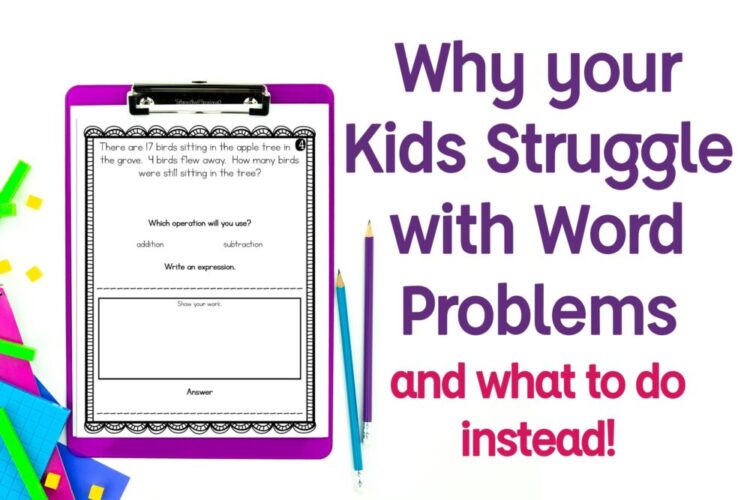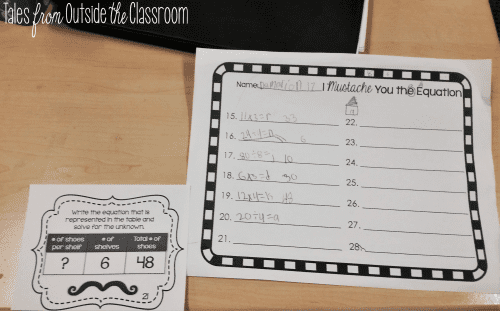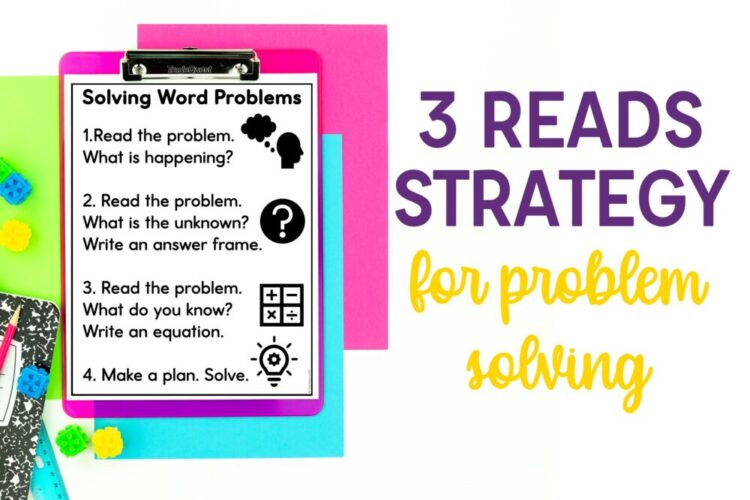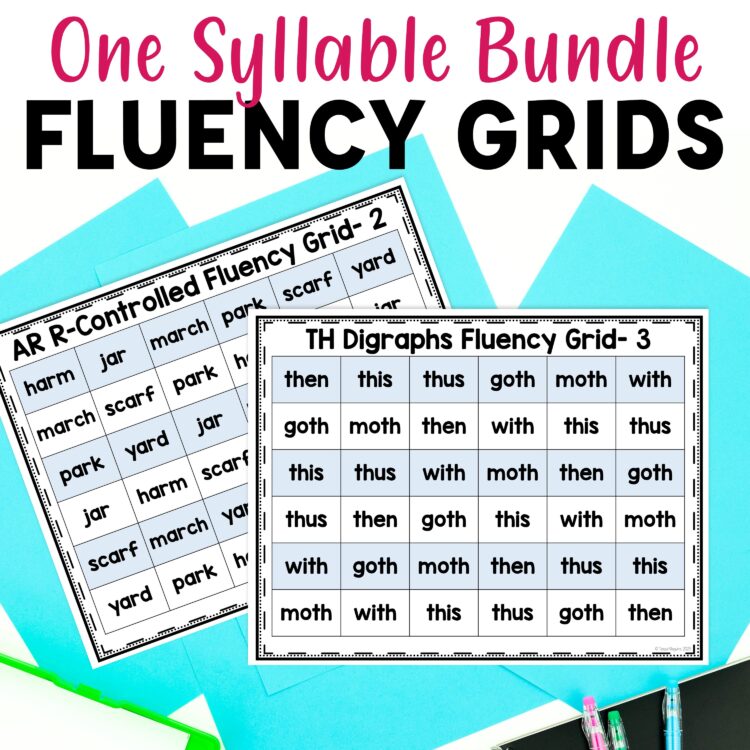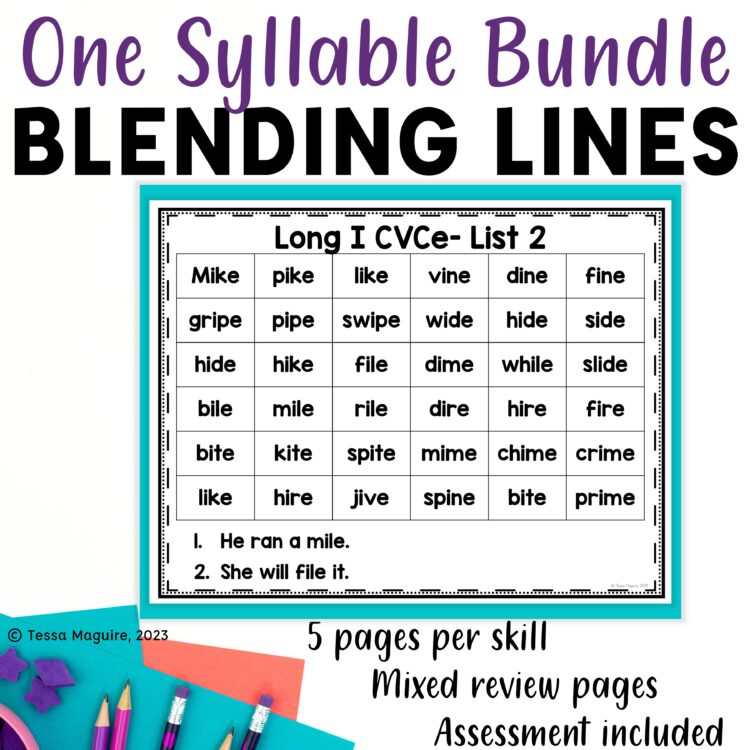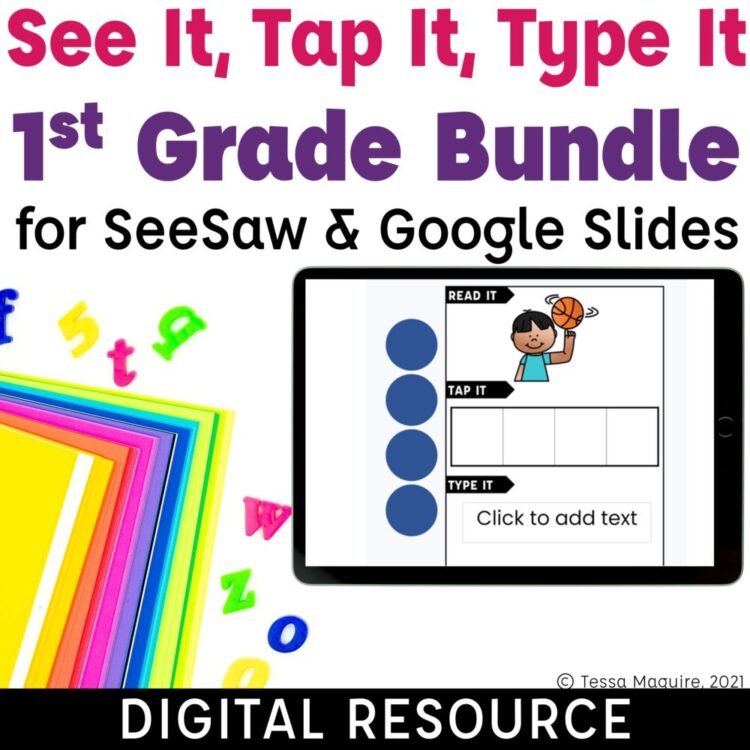© 2024 Tales from Outside the Classroom ● All Rights Reserved
Multiplication and Division Word Problem Types
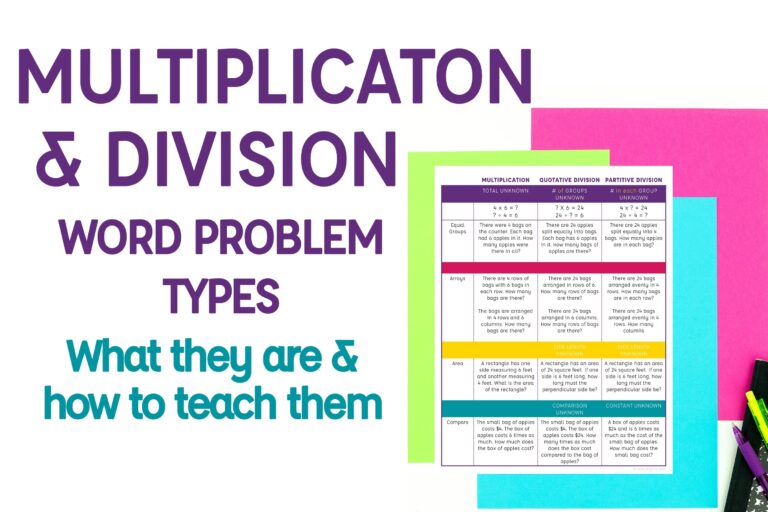
Word problems can be such a struggle. Especially in grades 3rd and up when students have to work through all of the operations and multi-step word problems. Students often struggle to identify the operation presented, or miss part of the steps needed to solve. Explicitly teaching word problem types can help our students recognize the operations in context. The Common Core State Standards lay out the different multiplication & division word problem types that students should know. By teaching them explicitly, we help students understand multiplication and division in context to help them truly understand the operations. We connect how the math they’re learning is relevant to their real life. By focusing on the word problems and their types, we’re focusing on what makes multiplication and division what they are.
This post takes an in-depth look at each of the multiplication & division word problem types. I also give some helpful links at the bottom that discuss Cognitively Guided Instruction, or CGI problem types. They use slightly different vocabulary than the CCSS but are the same set of skills. An important note- when I talk about teaching the multiplication & division word problem types explicitly, I don’t mean that they’re only practiced during a specific unit, or that we teach specific keywords for each problem type. Students need to read the problem and understand the context. Recognizing the problem type can support that work, but it’s not focused on keywords. I also do a daily word problem outside of our focused unit work. I firmly believe in spiraling the standards in word problems so students have to focus on context to solve. For more support with problem solving, check out my Why Your Students Struggle with Word Problems, and What You Can Do About It post.
An important note before we begin-throughout our exploration of both operations, we often return back to the total. We identify in our first lesson that multiplication allows us to find the total number of objects arranged in equal groups. When we begin exploring division, we know the total number of objects we have and have to find the unknown in connection with groups. Throughout our work, with arrays, area, and equal groups, we continue to come back to the concept of total to help students identify the operation needed. It is through identifying the total as known or unknown that students will truly understand the multiplication and division operations. As you will see, that’s a focus with each of the multiplication and division word problem types.
Equal Groups as Multiplication & Division
In my Introducing Multiplication and an Working with Division posts I walk through my hands-on, engaging lessons I use to introduce each operation. When introducing both operations, we focus on equal group arrangements. It’s crucial for students to understand that multiplication and division works with equal groups so it makes sense to begin here. When we first start working with multiplication and division word problems, I ask students to identify the items that are arranged in groups, and identify what that group looks like. For example, the group might be a box or a bag. Those objects could also just be objects in other scenarios. So, identifying that an object is grouped within something helps students to understand the word problem and that an equal group scenario is present.
| MULTIPLICATION | QUOTATIVE DIVISION | PARTITIVE DIVISION | |
| TOTAL UNKNOWN | # of GROUPS UNKNOWN | # in each GROUP UNKNOWN | |
|
4 x 6 = ? ? ÷ 4 = 6 |
? X 6 = 24
24 ÷ ? = 6 |
4 x ? = 24 24 ÷ 4 = ? |
|
| Equal Groups | There were 4 bags on the counter. Each bag had 6 apples in it. How many apples were there in all? | There are 24 apples split equally into bags. Each bag has 6 apples in it. How many bags of apples are there? | There are 24 apples split equally into 4 bags. How many apples are in each bag? |
MULTIPLICATION – Total Unknown
These are the word problems we typically think of with multiplication. It’s an arrangement of items into equal groups to find the total number of items. Identifying that the number of groups and the number of items into each group are known, while the total is unknown, helps students solve these word problems.
QUOTATIVE DIVISION – # of Groups Unknown
When the number of groups are unknown, it is a quotative division problem. Let me clear, I don’t teach my students the term quotative. Rather, I teach them that there are two types of division. When students are able to identify that the total number of objects is known, but the number of groups is unknown, they then know that they are dividing. It’s important that students have lots of practice with both types of division.
PARTITIVE DIVISION – # in each Group Unknown
When a word problem identifies the total number of items and how the items are arranged, but doesn’t give the number in each group, these are partitive division. Think of it as partitioning. The number of groups is known so the partitions are known. Again, I don’t teach this term with my students, but it’s important that students know that division is presented in two ways.
Once both operations have been introduced and practiced separately, I like to use my Multiplication & Division Scenario Tables Task Cards to practice writing equations and understanding group arrangements in context. I find that removing all of the components of the word problem, and working through just the total and group information, helps students truly understand the operations in connection with equal groups. This helps them then apply their learning within word problems. Students get practice with different ways items can be grouped, which helps them look for and identify grouping relationships in word problems later.
Arrays as Multiplication & Division
In conjunction with teaching equal group arrangements described above, arrays should also be included. Arrays are how students are first introduced to multiplication in 2nd grade. Students should have background knowledge with rows and columns vocabulary. Arrays are how I connect what we’re learning now, with what they learned before. Therefore, I teach arrays at the same time that I teach equal group arrangements. I correlate rows and the number of groups. I always emphasize that the columns are the same as the number in each row (or the group).
| MULTIPLICATION | QUOTATIVE DIVISION | PARTITIVE DIVISION | |
| TOTAL UNKNOWN | # of GROUPS UNKNOWN | # in each GROUP UNKNOWN | |
| 4 x 6 = ?
? ÷ 4 = 6 |
? X 6 = 24
24 ÷ ? = 6 |
4 x ? = 24 24 ÷ 4 = ? |
|
| Arrays | There are 4 rows of bags with 6 bags in each row. How many bags are there?
The bags are arranged in 4 rows and 6 columns. How many bags are there? |
There are 24 bags arranged in rows of 6. How many rows of bags are there?
There are 24 bags arranged in 6 columns. How many rows of bags are there? |
There are 24 bags arranged evenly in 4 rows. How many bags are in each row? There are 24 bags arranged evenly in 4 rows. How many columns of bags are there? |
It’s important to note that the CCSS lay out two rigors of array word problems: ones where the items in rows are presented, and those that give the word problem in rows and columns. Through continued exposure and practice, students understand that these are interchangeable. Array word problems are not very common, but are definitely a problem type that students should have exposure and practice with. They also lay the foundation for students to work with our next word problem type: area
Area as Multiplication and Division
Area is a critical component of our multiplication and division work. It’s a major part of 3rd grade math instruction and it’s important that students work with many word problems where they have to recognize area in context and solve. This is especially important to learn how to differentiate between area and perimeter by making connections between arrays and what is known about multiplication and division. Area should be introduced with arrays and connected to an area model. This concrete, visual example helps students connect what they already know (arrays) with their new learning (area). Unit squares are written in the standards to be this bridge. Area models continue on as you work with more the more complex rectilinear figures, and to help students understand the distributive property of multiplication. The CCSS don’t list area problems as their own line, rather, they’re included with arrays. While this certainly makes sense since arrays can be created inside the rectangle, and that’s how area should be introduced, most area word problems don’t use rows or columns when providing side lengths. I think it’s an important distinction to look at area word problems separate from arrays.
| SIDE LENGTH UNKNOWN | SIDE LENGTH UNKNOWN | ||
| Area | A rectangle has one side measuring 6 feet and another measuring 4 feet. What is the area of the rectangle? | A rectangle has an area of 24 square feet. If one side is 6 feet long, how long must the perpendicular side be? | A rectangle has an area of 24 square feet. If one side is 6 feet long, how long must the perpendicular side be? |
MULTIPLICATION
Solving area problems again connects back to total and known/unknown values. When students are trying to identify the total area of the shape, and are given both side lengths, students need to multiply to find the area.
DIVISION
When students are given the total area of the shape, but need to find a missing side length, they must divide.
Ultimately, if students have a solid understanding of multiplication and division word problems and their connection to total, they will likely be successful with area word problems.
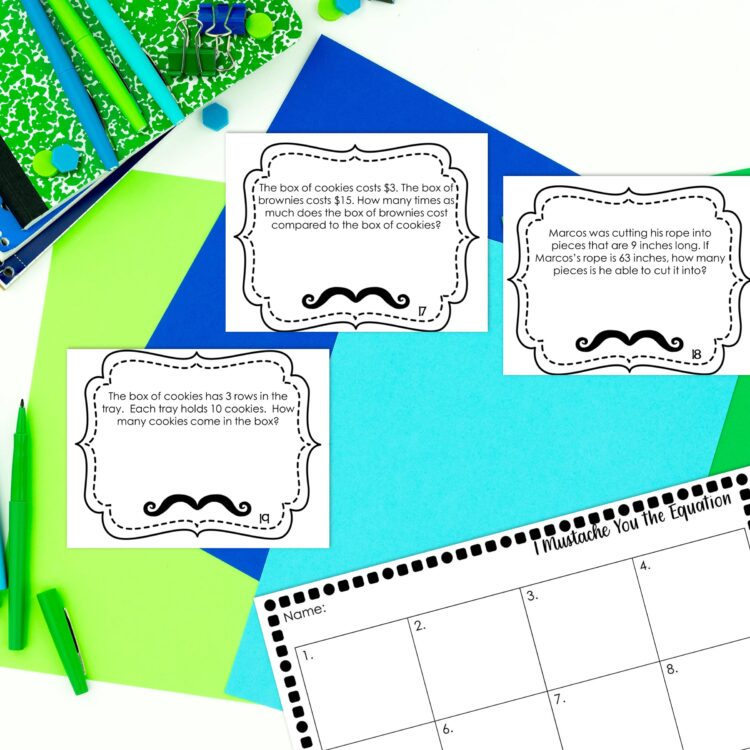
Comparison Word Problems
The most complex multiplication and division word problem types are comparison word problems, in my opinion. Just as they are in addition & subtraction, the way these problems are structured, cause them to be more complex than the others. For these, it’s important to look at each of the different problem types and digest what’s being given. I use a 3 Reads Routine when working through word problems, and these problems always bring the greatest discussion as students grapple with the information that’s presented.
| COMPARISON UNKNOWN | CONSTANT UNKNOWN | ||
| Compare | The small bag of apples costs $4. The box of apples costs 6 times as much. How much does the box of apples cost? | The small bag of apples costs $4. The box of apples costs $24. How many times as much does the box cost compared to the bag of apples? |
A box of apples costs $24 and is 6 times as much as the cost of the small bag of apples. How much does the small bag cost? |
The multiplication and partitive division (constant unknown) examples have very similar wording since they both have the comparison statement: “6 times as much”. This is a description of the relationship between two groups-the total, and the comparison group. The quotative (comparison) example is worded differently since the unknown is the comparison relationship: “How many times as much does”
The key to understanding multiplicative comparison problems is that the comparison is the repeating groups, whereas the constant is the group size.
In a multiplication word problem, you are told the amount in the comparison group, 6, and the constant, 4. Each bag of apples is $4, so if it’s 6 times as much, it’s the same as having 6 of the bags. Thus, 4 x 6.
In a (partitive) division word problem, you are given the total number (the cost of the box of apples). Once you partition, or divide, that cost into 6 equal groups, you are able to identify the cost of one of those groups, which is the same as the cost of the small bag of apples, and that is the same as the number of ducks.
In a (quotative) division word problem, you are given the constant, the cost of the small bag, along with the cost of the box of apples. The unknown is the relationship between them. With these word problems, the wording of the question can often throw students off.
Once students are able to decompose the word problem to identify the total, and the comparison, they’re able to connect that to what they already know about multiplication and division to help them when solving. Teaching students to closely read the word problem is key. To read more about my 3 Reads Routine you can click the image below.
Looking for additional resources? You can download my Multiplication & Division Word Problem Types reference sheet and use it to help identify and write the different word problem types for classroom practice.
Want additional multiplication & division word problem practice? I have a FREE Multiplication & Division Word Problem Task Cards set. Each of the multiplication & division word problem types discussed here are practiced during the 24 task card set. This is great practice for later in the year to ensure students have ample practice with each type. It would even be a great tool to help students discuss the different problem types and how they’re presented. To download the Multiplication & Division Word Problem Type Task Cards, just fill out the form below and they’ll be sent straight to your email.
Newsletter
Sign up to receive your free Multiplication & Division Word Problem Types Task Cards! After confirming your email, you’ll receive the file and be signed up for my weekly newsletter.
Thank you!
You have successfully joined our subscriber list.
You might also find the following links helpful.
Partitive & Quotative Division from SFUSD
CGI Resources from LAUSD
Multiplication & Division Word Problems from ND Counts
Two Ways of Thinking of Division from Langford Math
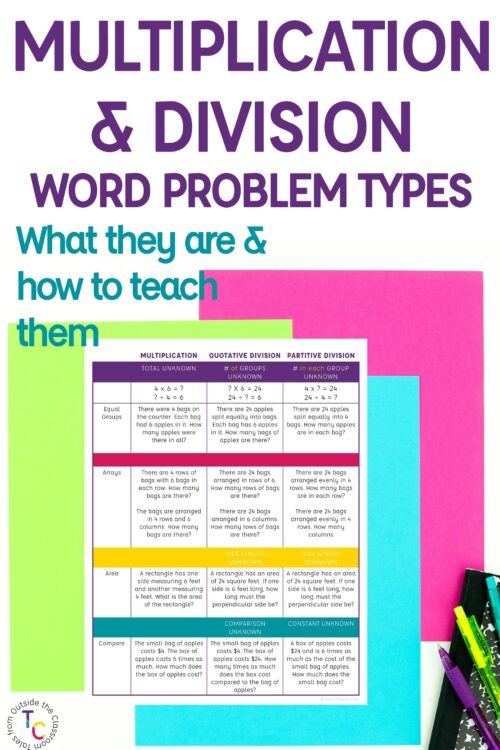
Newsletter Sign Up
Signup for my weekly-ish newsletter. I send out exclusive freebies, tips and strategies for your classroom, and more!
Please Read!
You have successfully joined our subscriber list. Please look in your e-mail and spam folder for Tales from Outside the Classroom. Often, the confirmation email gets overlooked and you're night signed up until you confirm!

Hi! I’m Tessa!
I’ve spent the last 15 years teaching in 1st, 2nd, and 3rd grades, and working beside elementary classrooms as an instructional coach and resource support. I’m passionate about math, literacy, and finding ways to make teachers’ days easier. I share from my experiences both in and out of the elementary classroom. Read more About Me.









